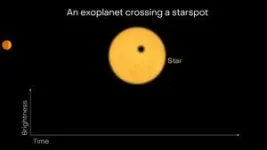(Press-News.org) Led by researchers from Université de Montréal's Trottier Institute for Research on Exoplanets (iREx), a team of astronomers has harnessed the power of the revolutionary James Webb Space Webb Telescope (JWST) to study the "hot Saturn" exoplanet HAT-P-18 b.
Their findings, published last month in the journal Monthly Notices of the Royal Astronomical Society, paint a complete picture of the HAT-P-18 b's atmosphere while exploring the great challenge of distinguishing its atmospheric signals from the activity of its star.
HAT-P-18 b is located over 500 light-years away with a mass similar to Saturn’s but a size closer to that the larger planet Jupiter. As a result, the exoplanet has a "puffed-up" atmosphere that is especially ideal for analysis.
Passing over a spotted star
Observations from the JWST were taken while the HAT-P-18 b was passing in front of its Sun-like star. This moment is called a transit and is crucial to detect and further characterise an exoplanet from hundreds of light-years away with surprising precision.
Astronomers don't observe light that is being emitted directly by the distant planet. Rather, they study how the central star’s light is being blocked and affected by the planet orbiting it, and so must try to disentangle signals caused by the presence of the planet from those caused by the star’s own properties.
Just like our Sun, stars do not have uniform surfaces. They can have dark star spots and bright regions, which can create signals that mimic a planet’s atmospheric attributes. A recent study of the exoplanet TRAPPIST-1 b and its star TRAPPIST-1 led by UdeM doctoral student Olivia Lim witnessed an eruption, or flare, on the surface of the star, which affected observations.
In the case of planet HAT-P-18 b, Webb caught the exoplanet right as it was passing over a dark spot on its star, HAT-P-18. This is called a spot-crossing event, and its effect was evident in the data collected for the new study. The iREx team also reported the presence of numerous other star spots on HAT-P-18’s surface which were not blocked out by the exoplanet.
To accurately determine the exoplanet’s atmospheric composition, the researchers had to simultaneously model the planet's atmosphere as well as its star’s peculiarities. In their study, they point out that such consideration will be crucial in treating future exoplanet observations via the Webb to fully harness their potential.
“We found that accounting for stellar contamination implies the existence of spots and clouds instead of haze and recovers a water vapour abundance of almost an order of magnitude lower,” said lead author Marylou Fournier-Tondreau.
“So considering the system’s host star makes a big difference," added Fournier-Tondreau, who did the work as a master's student at iREx and is now pursuing a Ph.D. at the University of Oxford.
"It’s actually the first time that we clearly disentangle the signature of hazes versus starspots, thanks to Canada's NIRISS (Near-Infrared Imager and Slitless Spectrograph) instrument, which provides wider wavelength coverage extending into the visible light domain.”
H2O, CO2, and clouds in a scorching atmosphere
After modelling the exoplanet and the star in the HAT-P-18 system, the iREx astronomers performed a meticulous dissection of HAT-P-18 b’s atmospheric composition. By inspecting the light that filters through the exoplanet’s atmosphere as it transits its host star, the researchers discerned the presence of water vapour (H2O) and carbon dioxide (CO2).
The researchers also detected the possible presence of sodium and observed strong signs of a cloud deck in HAT-P-18 b’s atmosphere, which appears to be muting the signals of many of the molecules found within it. They also concluded that the star’s surface was covered by many dark spots that can significantly influence the interpretation of the data.
An earlier analysis of the same JWST data led by a team at Johns Hopkins University had also revealed a clear detection of water and CO2, but also reported the detection of small particles at high-altitudes called hazes and found hints of methane (CH4). The iREx astronomers paint a different picture.
The CH4 detection was not confirmed, and the water abundance they determined was 10 times lower than previously found. They also found that the previous study’s detection of hazes could instead be caused by star spots on the star’s surface, highlighting the importance of considering the star in the analysis.
Could the exoplanet support life? Not likely. While molecules like water, carbon dioxide, and methane can be interpreted as biosignatures, or signs of life, in certain ratios or in combination with other molecules, HAT-P-18 b’s scorching temperatures of close to 600 degrees Celsius do not bode well for the planet’s habitability.
Future observations from another JWST instrument, the Near Infrared Spectrograph (NIRSpec), promise to help refine the team’s results, such as the CO2 detection, and shed even more light on the intricacies of this hot Saturn exoplanet.
About this study
“Near-infrared transmission spectroscopy of HAT-P-18 b with NIRISS: disentangling planetary and stellar features in the era of JWST,” by Marylou Fournier Tondreau et al, was published Dec. 9, 2023, in Monthly Notices of the Royal Astronomical Society.
END
Unlocking the secrets of a "hot Saturn" and its spotted star
2024-01-09
ELSE PRESS RELEASES FROM THIS DATE:
RSV shown to infect nerve cells, cause inflammation and damage
2024-01-09
Respiratory syncytial virus (RSV), a common infection in children and senior adults, can also infect nerve cells and trigger inflammation leading to nerve damage, according to a new Tulane University study.
RSV can cause mild symptoms such as coughing, sneezing and fever or lead to more severe conditions such as pneumonia or bronchiolitis. But since the disease was first discovered in 1956, it has been thought to only infect the respiratory tract.
This study, published in The Journal of Infectious Diseases, is the first to prove that RSV can penetrate nerve cells and may provide the ...
A common marker of neurological diseases may play role in healthy brains
2024-01-09
https://www.ninds.nih.gov/news-events/press-releases/common-marker-neurological-diseases-may-play-role-healthy-brainsResearchers have discovered that a protein called phosphorylated α-synuclein, which is associated with several neurodegenerative diseases such as Parkinson’s disease and Lewy body dementia, is also involved in the normal processes of how neurons communicate with each other in a healthy brain. The research, published in Neuron, was funded in part by the National Institute of Neurological Disorders and Stroke (NINDS), a part of the National Institutes of Health.
Phosphorylation is a process where a phosphate ...
ChatGPT poem regurgitation raises ethical questions
2024-01-09
ITHACA, N.Y. – Ask ChatGPT to find a well-known poem and it will probably regurgitate the entire text verbatim – regardless of copyright law – according to a new study by Cornell University researchers.
The study showed that ChatGPT was capable of “memorizing” poems, especially famous ones commonly found online. The findings pose ethical questions about how ChatGPT and other proprietary artificial intelligence models are trained – likely using data scraped from the internet, researchers said.
“It’s generally not good for large language models to memorize large chunks of text, in part because it’s a privacy concern,” ...
Sickle cell raises COVID-19 risk, but vaccination lags
2024-01-09
Despite the fact that people with sickle cell disease have a much higher risk of serious illness or death if they develop COVID-19, a new study shows they’re also much less likely than those without sickle cell disease to have gotten vaccinated against coronavirus.
Completion of the initial COVID-19 vaccination series was nearly two times lower for adults with sickle cell disease as others their age, the analysis of data in Michigan shows.
In in teens and children over 5, who overall have lower rates of COVID-19 vaccination, those with sickle cell disease were far less likely than other young people to have gotten their doses by summer 2022, the analysis ...
Brookline Housing Authority partners with Hebrew SeniorLife for health and social services in senior housing
2024-01-09
The Brookline Housing Authority (BHA) has partnered with Hebrew SeniorLife, New England’s largest nonprofit provider of senior health care and living communities, and the only senior care organization affiliated with Harvard Medical School, to provide community life services including resident services, fitness, social programming, and nursing in BHA’s senior housing sites.
Hebrew SeniorLife brings to the BHA its model of housing with services called the Right Care, Right Place, Right Time (R3) program. This model uses a preventive approach to resident services, focused on one-on-one relationship building, community-wide ...
Sylvester-led research group unveils the first individual risk prediction model for multiple myeloma
2024-01-09
MIAMI, FLORIDA (EMBARGOED UNTIL JAN. 9, 2024 AT 4 PM EST) – A multicenter collaboration led by researchers at Sylvester Comprehensive Cancer Center at the University of Miami Miller School of Medicine has produced the first computational model for newly diagnosed multiple myeloma that predicts an individual’s personalized prognosis based on their tumor genomics and treatments.
The prediction model for individualized risk in newly diagnosed multiple myeloma, or IRMMa, improves on previous prognostic tools because it takes into account ...
Systemic changes induced by ASCOT in plasma proteome of women with impaired ovarian reserves
2024-01-09
“Identifying plasma proteins that regenerate aged or damaged ovaries could lead to more effective, targeted and/or preventive therapies for patients.”
BUFFALO, NY- January 9, 2024 – A new research paper was published in Aging (listed by MEDLINE/PubMed as "Aging (Albany NY)" and "Aging-US" by Web of Science) Volume 15, Issue 24, entitled, “Systemic changes induced by autologous stem cell ovarian transplant in plasma proteome of women with impaired ovarian reserves.”
Patients with poor ...
Green wheels, bright skies: NREL analysis unveils the connection between electric vehicles and photovoltaics
2024-01-09
People who own electric vehicles (EVs) are more likely to go a step further and add solar panels to their home, according to an analysis of a behavioral study by researchers at the U.S. Department of Energy’s National Renewable Energy Laboratory (NREL). Conversely, the impact of owning solar panels also has a bearing on whether a homeowner buys an electric vehicle but not as strongly.
The study relied on a survey of 869 households in the San Francisco Bay Area.
NREL’s Shivam Sharda, lead author of the newly published research paper that analyzes the ...
V Foundation grant enables research on radiation resistance in pancreatic cancer treatment
2024-01-09
University of Colorado Cancer Center member Sana Karam, MD, PhD, has received a translational research grant from the V Foundation for Cancer Research, co-founded by ESPN and legendary basketball coach Jim Valvano, to study a new therapeutic that may help pancreatic cancer patients overcome resistance to radiation therapy.
“Pancreatic cancer is deadly. The only treatment that can cure it is surgery to fully remove the tumor, but that is only an option when the cancer is caught early, which is rare,” Karam explains. “Radiation alone to shrink tumors before surgery has been tried, but with limited benefit. By studying patient ...
The role of fibronectin in BRAF-mutant thyroid cancer treatment
2024-01-09
New research overseen by University of Colorado Cancer Center member Rebecca Schweppe, PhD, could lead to improved treatment for people with thyroid cancer characterized by a mutation in the BRAF gene — a mutation also responsible for some types of melanoma, colorectal cancer, leukemia, lymphoma, and ovarian cancer.
“The BRAF mutation is a common mutation in thyroid cancer,” Schweppe says. “It has a high prevalence of mutations in two different subtypes — papillary thyroid cancer, or PTC, and anaplastic thyroid cancer, or ATC — and there's a lot of interest in targeting this pathway. Other tumor types, like melanoma ...




